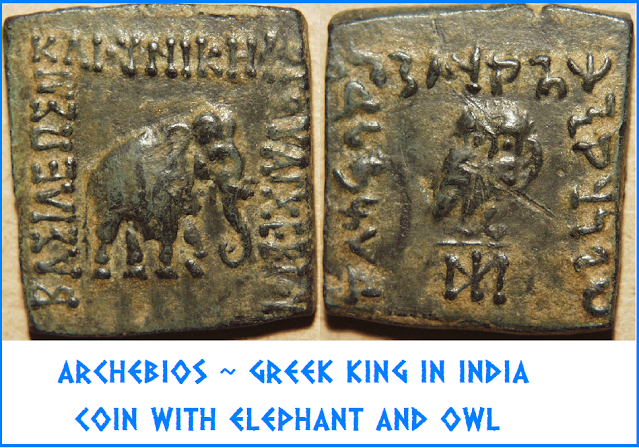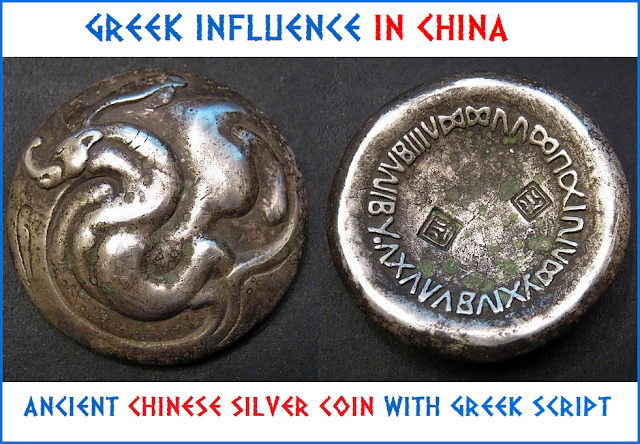Saturday, 29 April 2023
IMAGES OF THE GREEK GODS IN THE TURKISH LANGUAGE
Thursday, 27 April 2023
ANCIENT CHINESE SILVER COIN WITH GREEK SCRIPT
Silver Bai Jin San Pin, Dragon Coin, from Emperor Han Wudi 119 BCE. the Dragon Coin.
Issued by Emperor Wu Di of the Western Han dynasty, presumably to strengthen trade with the Greco-Bactrian state since the script is in Greek characters.
The territory of Bactria was called 大夏 Dàxià in Chinese. On the obverse we see a dragon. The reverse legend is in Greek characters.There have been many attempts to decipher the meaning but it seems it doesn't make sense in any way.2 chop marks, shao 少 for shao fu 少府 (emperor's private Treasury).Shao Fu 少府 mint.
Monday, 24 April 2023
THE GREEK PRESENCE IN INDIA AND THE SPREADING OF HELLENIC CULTURE IN ASIA
The Indo-Greek Kingdom, or Greco-Indian Kingdom, also known historically as the Yavana Kingdom, was a Hellenistic-era Greek kingdom covering various parts of Afghanistan, the northwest regions of the Indian subcontinent, (all of present Pakistan), and a small part of Iran; from 180 BCE to around 10 CE.
The Kingdom began when the Greco-Bactrian king Demetrius invaded India in 180 BCE, ultimately creating an entity which seceded from the powerful Greco-Bactrian Kingdom centered in Bactria.
Preliminary Greek presence in India
In 326 BCE, Alexander The Great conquered the north-western part of the Indian subcontinent as far as the Hyphasis River, and established satrapies.
Later in 303 BCE, after a peace treaty between Seleucus and Chandragupta, Seleucus received 500 elephants from Chandragupta, settled Megasthenes in Pataliputra, whereas Chandragupta married Helena,the sister of Seleucus. This strengthened the relations between the two kingdoms and and established Greek culture and knowledge in the royal court of Chandragupta.
Also, several Greeks, such as the historian Megasthenes followed by Deimachus and Dionysius, went to reside at the Mauryan court. The two rulers continued to exchange presents.
On these occasions, Greek populations apparently remained in the northwest of the Indian subcontinent under Mauryan rule.Further, in his edicts, Ashoka claims he sent Buddhist emissaries to Greek rulers as far as the Mediterranean.
The Greeks in India played an active role in the propagation of Buddhism.
Greek rule in Bactria
Bactria or Bactriana, was an ancient region in Central Asia.
Alexander also had established in neighboring Bactria several cities (Ai-Khanoum, Begram) and an administration that lasted more than two centuries under the Seleucids and the Greco-Bactrians, all the time in direct contact with Indian territory.
History of the Indo-Greek kingdom
The invasion of northern India, and the establishment of the “Indo-Greek kingdom,” started around 180 BCE when Demetrius I, son of the Greco-Bactrian king Euthydemus I, led his troops across the Hindu Kush.
Apollodotus, seemingly a relative of Demetrius, led the invasion to the south, while Menander, led the invasion to the east.
Possibly at a later period, the Greeks advanced to the Ganges River, apparently as far as the capital Pataliputra, under the orders of Menander.
According to the Greek geographer Strabo (Greek Geographer), Greek advances temporarily went as far as the Sunga capital Pataliputra (today Patna) in eastern India.
To the south, the Greeks may have occupied the areas of the Sindh and Gujarat down to the region of Surat (Greek: Saraostus) near Mumbai (Bombay), including the strategic harbor of Barygaza (Bharuch)
The majority of historians consider Menander (reigned c.165/155 –130 BCE) the most successful Indo-Greek king, and the conqueror of the greatest territory.
Following Menander’s reign, about 20 Indo-Greek kings ruled in succession in the eastern parts of the Indo-Greek territory.
Later at around 125 BCE, The Indo-Greeks thus suffered encroachments by the Greco-Bactrians in their western territories.
An inscription on a signet ring of the 1st century CE in the name of a king Theodamas, from the Bajaur area of Gandhara, in modern Pakistan constitutes the last known mention of an Indo-Greek ruler.
Buddhism flourished under the Indo-Greek kings, and their rule, especially that of Menander, has been remembered as benevolent.
The Greek expansion into Indian territory may have been intended to protect Greek populations in India, and to protect the Buddhist faith from the religious persecutions of the Sungas.
Most coins of the Greek kings in India in Greek on the front and in Pali on the back (in the Kharoshthi script), which indicate a tremendous concession to another culture never before made in the Hellenic world.
Religion
In addition to the worship of the Hellenic Pantheon of the Greek Gods and Goddesses found on their coins (Zeus, Heracles, Athena, Apollo…), the Indo-Greeks involved with local faiths, particularly with Buddhism, but also with Hinduism and Zoroastrianism.
Histories describe Menander I, the “Saviour king,” seemingly a convert to Buddhism, as a great benefactor of the religion, on a par with Ashoka or the future Kushan emperor Kanishka
Art
Historians generally consider the coinage of the Indo-Greeks as some of the most artistically brilliant of Antiquity. The Gandhara Greek Art movement has given the first ever depictions of the Buddha in human form, with all the typical elements of Greek sculptural art.
Coins
The adoption of Indo-Greek monetary conventions by neighbouring kingdoms, such as the Satavahanas, also suggest that Indo-Greek coins were used extensively for cross-border trade.
An indirect testimony by the Chinese explorer Zhang Qian, who visited Bactria around 128 BCE, suggests that intense trade with Southern China went through northern India.
Zhang Qian explains that he found Chinese products in the Bactrian markets, transiting through North-western India, which he incidentally describes as a civilization similar to that of Bactria
Maritime relations across the Indian Ocean started in the third century BCE, and further developed during the time of the Indo-Greeks together with their territorial expansion along the western coast of India, along the Indus delta and Kathiawar peninsula or Muziris.
Armed forces
The coins of the Indo-Greeks provide rich clues on their uniforms and weapons depicting typical Hellenistic uniforms, with helmets being either round in the Greco-Bactrian style, or the flat Kausia of the Macedonians.
The Milinda Panha, in the questions of Nagasena to king Menander, provides a rare glimpse of the military methods of the period.
Thus, presently 36 Indo-Greek kings are known. Several of them are also recorded in Western and Indian historical sources, but the majority are known through numismatic evidence only. The exact chronology and sequencing of their rule is still a matter of scholarly inquiry, with adjustments regular being made with new analysis and coin finds.
For more information about the Greek influence in India, see HERE https://greekasia.blogspot.com/2019/10/the-hidden-greek-roots-of-indian.html
edited from insightsonindia.com
-
Bronze Corinthian helmet found in 5th century BCE burial mound in Taman Peninsula, Russia. Source: Institute of Archaeology of Russi...
-
One of Greece’s Ancient Missing Link Found: An Inquiry into Ethnic Identity, Ideology and Historical Revisionism among Contemporary Pash...
-
This very interesting Google map includes a lot of major Ancient Greek archaeological sites in various countries and it is regularly updated...
-
The Battle at the Gravia Inn (Greek: Μάχη στο Χάνι της Γραβιάς) took place in May 8th, 1821 and was fought between Greek revolutionaries...
-
During excavations in the Hellenistic city of Ai- Khanoum, French archaeologists discovered a giant marble foot in the main temple, carv...
-
The Ancient Greeks called the weekdays ' Days of the Gods.' They named each day after the Sun ,the Moon, and five of the Gods. Roma...
-
Alexander the Great and his army began a massive military campaign in 334 BCE, which resulted in Macedonians establishing many Greek citi...
-
The God Dionysos was the first to campaign to India 6451 years before alexander 154 king before androcotos ( also known as Chandragupta)...
-
When Alexander the Great liberated the West Indies from the Persians, the Indians had no connection with the ancient culture of the Indu...
-
The mark of the Indo-Greek kingdoms on Buddhism , is well known. From King Menander , who protected and promoted Buddhism, to the art o...






















































































